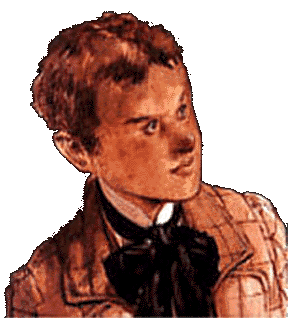


"It was as if Nature, in its infinite wisdom,
after having created a Father who was a Genius for Evil,
had created a Son who was a Genius for Good."
("Le Parfum de la Dame en Noir" - Chapter 4)
Created & Written by: Gaston Leroux (1868-1927)
 The leading feuilletoniste of
the Belle Époque was Gaston Leroux,
a writer best known for his classic Le Fantôme de l'Opéra (The Phantom Of The Opera)
(1910), about which little need be said, the tragic yet murderous man-ape Balaoo (1911) and Cheri-Bibi.
The leading feuilletoniste of
the Belle Époque was Gaston Leroux,
a writer best known for his classic Le Fantôme de l'Opéra (The Phantom Of The Opera)
(1910), about which little need be said, the tragic yet murderous man-ape Balaoo (1911) and Cheri-Bibi.
Trained as a lawyer, Leroux was a renowned investigative journalist who even traveled to, and reported from, Russia
just before the Bolshevik Revolution. His journalistic skills helped the French fantastique emerge from the gothic and romantic literary morass of the end of the 19th century, and, by
making it more contemporary and real, gave it a new lease on life.
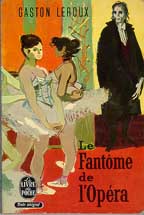 In Le Fantôme de l'Opéra (which takes place in 1880), Leroux skillfully mixed fantastic events with real-life facts.
The novel reads like sensational newspaper accounts of the surreal. When Leroux dealt with fantastic themes, it
was in ways that were resolutely modern, but often derivative of the works of other popular writers, such as Edgar
Allan Poe, H. Rider Haggard, Paul Féval, Alexandre Dumas, etc.
In Le Fantôme de l'Opéra (which takes place in 1880), Leroux skillfully mixed fantastic events with real-life facts.
The novel reads like sensational newspaper accounts of the surreal. When Leroux dealt with fantastic themes, it
was in ways that were resolutely modern, but often derivative of the works of other popular writers, such as Edgar
Allan Poe, H. Rider Haggard, Paul Féval, Alexandre Dumas, etc.
Today, Gaston Leroux is best remembered as the author of a series of mystery novels, starring the character of
dashing young journalist, Joseph Rouletabille,
clearly an idealized projection of the author.
Like Auguste Dupin, Lecoq, Sherlock Holmes and Hercule
Poirot, Rouletabille solved his cases by pure deductive reasoning, what he
called the "good end of reason." He drew a figurative circle around the facts that were known, and excluded
everything that was not part of that circle, even if they appeared to be. The Rouletabille series included few
genre elements, but was filled with a remarkable gothic atmosphere.
 In the first novel of the series, Le Mystère
de la Chambre Jaune (published in 1907; allegedly taking place in 1892, although
it is likely that the story actually took place in 1902 according to the series' internal chronology), Rouletabille
solved an attempted murder in a locked room. In the book, Leroux revealed that "Rouletabille" is but
the nickname of 18-year-old journalist Joseph Josephin, who was raised in a religious orphanage in Eu, a small
town on the western coast of France, near Fecamp. It turns out that Rouletabille's father is none other than Ballmeyer, an international criminal of great repute and
many identities. As "Jean Roussel", Ballmeyer had married a rich American heiress, Mathilde
Stangerson, the "Lady in Black" -- Rouletabille's mother.
In the first novel of the series, Le Mystère
de la Chambre Jaune (published in 1907; allegedly taking place in 1892, although
it is likely that the story actually took place in 1902 according to the series' internal chronology), Rouletabille
solved an attempted murder in a locked room. In the book, Leroux revealed that "Rouletabille" is but
the nickname of 18-year-old journalist Joseph Josephin, who was raised in a religious orphanage in Eu, a small
town on the western coast of France, near Fecamp. It turns out that Rouletabille's father is none other than Ballmeyer, an international criminal of great repute and
many identities. As "Jean Roussel", Ballmeyer had married a rich American heiress, Mathilde
Stangerson, the "Lady in Black" -- Rouletabille's mother.
(FOR SOME SPECULATIONS ON BALLMEYER, SEE OUR ARTICLE ON MONSIEUR
LECOQ.)
In a tragic irony of fate, Rouletabille unmasked Ballmeyer, who was hiding under the guise of French Surete detective
Frederic Larsan, in 1902, and saved his
mother from his father's evil designs.
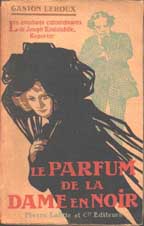 The story continued three years later, in 1905, when Ballmeyer returned in the
story chronicled by Leroux under the title of Le Parfum de la Dame en Noir (The Scent of the Lady in Black).
At the end of the story, which took place in a castle by the sea in Southern France, Ballmeyer died, freeing Rouletabille
from the evil shadow of the past.
The story continued three years later, in 1905, when Ballmeyer returned in the
story chronicled by Leroux under the title of Le Parfum de la Dame en Noir (The Scent of the Lady in Black).
At the end of the story, which took place in a castle by the sea in Southern France, Ballmeyer died, freeing Rouletabille
from the evil shadow of the past.
That same year, in 1905, Rouletabille was summoned to Russia by the Czar, and solved a murder at the Imperial Court.
In subsequent novels, the fearless journalist married the beautiful Ivana Vilitchkov and defeated the mad Turk warlord Gaulow, Lord of the Black Castle.
Then, Rouletabille became a French secret agent and infiltrated the Krupp factories. Later, he was almost framed
for Ivana's murder. Then, Rouletabille helped recover a sacred book stolen from the gypsies and managed to thwart
the evil schemes of the deadly Madame de Mayrens,
aka La Pieuvre (The Octopus).


TO FIND OUT MORE, BUY THESE BOOKS
THE BOOKS
1. Le Mystère de la Chambre Jaune
(The Mystery Of The Yellow Room) ("L'Illustration",
1907; rev. Lafitte, 1908; transl. 1908)
2. Le Parfum de la Dame en Noir (The Scent of the Lady In Black) ("L'Illustration",
1908; rev. Lafitte, 1909)
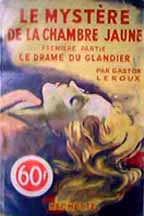
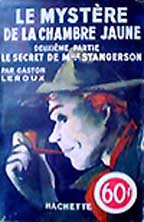
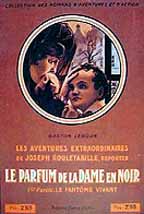


3. Rouletabille chez le Tsar (Rouletabille and the Czar) ("L'Illustration"/Lafitte,
1913)
4. Rouletabille à la Guerre (Rouletabille at War)
("Le Matin", 1914; rev. 2 vols. as Le Château Noir (The Black
Castle) and Les Étranges Noces de Rouletabille (The
Strange Wedding Of Rouletabille), Lafitte, 1916)
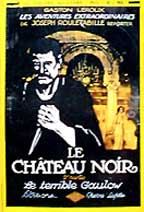
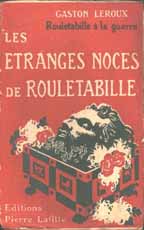

5. Rouletabille Chez Krupp
(Rouletabille at Krupp's) (JST, 1917;
rev. Lafitte, 1920)
6. Le Crime de Rouletabille (The Crime of Rouletabille) (JST, 1921; rev. Lafitte, 1923)
7. Rouletabille chez les Bohémiens
(Rouletabille and the Gypsies) ("Le
Matin", 1922; rev. Lafitte, 1923)
Authorized Sequels Written by Noré Brunel:
8. Rouletabille contre la Dame de Pique
(Rouletabille vs. The Queen Of Spades)
("Soir", 1947)
9. Rouletabille Joue et Gagne (Rouletabille Plays and Wins) ("Soir", 1947)
THE FILMS
1. Le Mystère de la Chambre Jaune (B&W.,
905 meters, 1913)
Dir/Wri: Maurice Tourneur.
Cast: Marcel Simon (Rouletabille), Paul
Escoffier (Larsan), Laurence Duluc (Mathilde).
2. Le Parfum de la Dame en Noir
(B&W., 1220 meters, 1914)
Dir/Wri: Émile Chautard.
Cast: Maurice Le Féraudy (Rouletabille),
Jean Garat, Devalence, Mme. Van Doren.
 3. Rouletabille chez les Bohémiens
(B&W., 8000 meters, 1922)
3. Rouletabille chez les Bohémiens
(B&W., 8000 meters, 1922)
Dir: Henri Fescourt.
Wri: Gaston Leroux.
Cast: Gabriel de Gravone (Rouletabille),
Joe Hamman, Romuald Joublé, Edith Jehanne, Jean Dehelly, Suzanne Talba.
 |
 4. Le Mystère de la Chambre Jaune (B&W., 108 min., 1931) 4. Le Mystère de la Chambre Jaune (B&W., 108 min., 1931)
Dir/Wri: Marcel L'Herbier.
Cast: Roland Toutain (Rouletabille), Marcel
Vilbert (Larsan), Huguette Ex-Duflos (Mathilde), Edmond Van Daële (Darzac).
5. Le Parfum de la Dame en Noir
(B&W., 109 min., 1931)
Dir/Wri: Marcel L'Herbier.
Cast: Roland Toutain (Rouletabille), Marcel
Vilbert (Larsan), Huguette Ex-Duflos (Mathilde), Edmond Van Daële (Darzac). |
6. Rouletabille Aviateur (B&W., 100 min., 1932)
Dir: Étienne Szekely.
Wri: Pierre Veber.
Cast: Roland Toutain (Rouletabille), Léon
Bélières, Lisette Lanvin.
Note: Original story written with the
permission of the Leroux Estate.
7. Rouletabille Joue et Gagne
(B&W., 95 min., 1947)
Dir: Christian Chamborant.
Wri: Pierre Lestringuez.
Cast: Jean Piat (Rouletabille), Marie
Déa, Lucas-Gridoux.
Note: Original story written with the
permission of the Leroux Estate.
8. Rouletabille contre la Dame de Pique
(B&W., 88 min., 1948)
Dir: Christian Chamborant.
Wri: Pierre Lestringuez.
Cast: Jean Piat (Rouletabille), Marie
Déa, Lucas-Gridoux.
Note: Original story written with the
permission of the Leroux Estate.
 9. Le Mystère de la Chambre Jaune (Col., 90 min., 1949) 9. Le Mystère de la Chambre Jaune (Col., 90 min., 1949)
Dir: Henri Aisner.
Wri: Wladimir Pozner.
Cast: Serge Reggiani (Rouletabille), Marcel
Herrand (Larsan), Hélène Perdrière (Mathilde), Lucien Nat (Darzac).
10. Le Parfum de la Dame en Noir
(Col., 109 min., 1931)
Dir: Louis Daquin.
Wri: Wladimir Pozner.
Cast: Serge Reggiani (Rouletabille), Marcel
Herrand (Larsan), Hélène Perdrière (Mathilde), Lucien Nat (Darzac). |
 |
|

11. Le Mystère de la Chambre Jaune (Col.,
in production)
Dir/Wri: Bruno Podalydes.
Cast: Denis Podalydes (Rouletabille),
Pierre Arditi (Larsan), Sabine Azema (Mathilde) Olivier Gourmnet (Darzac), Jean-Noël Broute (Sainclair), Michael
Lonsdale (Stangerson).
Note: Film in development from Why Not Productions.
Podalydes & Broute (Right).
|
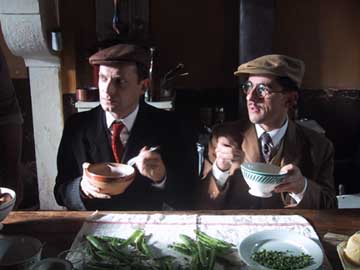 |
TELEVISION
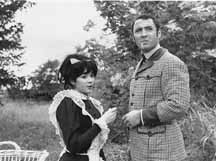 1. Le Mystère de la Chambre Jaune (ORTF 1, B&W., 90 min., 27 November 1965)
1. Le Mystère de la Chambre Jaune (ORTF 1, B&W., 90 min., 27 November 1965)
Dir: Jean Kerchbron.
Wri: Jean Gruault, Jean Kerchbron.
Cast: Claude Brasseur (Rouletabille),
François Maistre (Larsan), Marika Green (Mathilde), Lucien Nat, Géo Wallery, Jean Champion.
2. Le Parfum de la Dame En Noir (ORTF
1, B&W., Ten 15 min. episodes, 3 - 14 March 1966)
Dir: Yves Boisset.
Wri: Bernard Dabry, Guy Jorré.
Cast: Philippe Ogouz (Rouletabille), Raymond
Loyer (Darzac), Nicole Maurey (Mathilde), Aimé Demarch, Lucien Raimbourg, Tania Lopert, René Lefèvre.
 3. Rouletabille chez le Tsar (ORTF 1, B&W., Ten 15 min. episodes, 17 - 30 March 1966)
3. Rouletabille chez le Tsar (ORTF 1, B&W., Ten 15 min. episodes, 17 - 30 March 1966)
Dir: Jean-Charles Lagneau.
Wri: Bernard Dabry, Guy Jorré.
Cast: Philippe Ogouz (Rouletabille), Maria
Meriko (Matrena), Julien Guiomar (Trebassof), Paloma Matta, Georges Claisse, Pierre Tornade.
Story: Rouletabille
4. Rouletabille chez les Bohémiens
(ORTF 1, B&W., Ten 15 min. episodes, 31 March - 13 April 1966)
Dir: Robert Mazoyer.
Wri: Bernard Dabry, Guy Jorré.
Cast: Philippe Ogouz (Rouletabille), Tania
Balachova (Zina), Judith Magre (Calista), Caroline Cellier, Annie Savarin, Henri Piégay, Henri Virlojeux,
Jacques Robiolles.

RADIO
1. Le Mystère de la Chambre Jaune
(Radio-Luxembourg, 19 November 1953)
Dir/Wri: No information available.
Voices: François Périer
(Rouletabille), Daniel Lecourtois (Larsan), Françoise Morhange (Mathilde).
2. Le Mystère de la Chambre Jaune
(RTFB, April 1965)
Dir/Wri: No information available.
Voices: No information available.
3. Le Crime de Rouletabille (Rouletabille's Crime) (in Enigmes
et Aventures, Radio-Sottens, 17 April 1983)
Wri: Anne-Marie Rhyn.
 4. Le Mystère de la Chambre Jaune (France-Culture, 25 episodes, 1 August-2
September 1983)
4. Le Mystère de la Chambre Jaune (France-Culture, 25 episodes, 1 August-2
September 1983)
Dir: Jean-Jacques Vierne.
Wri: Philippe Derrez.
Voices: Philippe Nicaud (Rouletabille),
Philippe Derrez (Sinclair), François Maistre (Larsan), Evelyne Selena (Mathilde).
5. Le Parfum de la Dame en Noir
(France-Culture, 20 episodes, 1st-25 October 1985)
Dir: Jean-Jacques Vierne.
Wri: Philippe Derrez.
Voices: Philippe Nicaud (Rouletabille),
Philippe Derrez (Sinclair), Jean-François Calvé (Darzac/Larsan), Claire Maurier (Mathilde).
THE COMICS
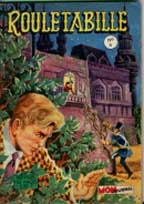 |
1. Rouletabille
(32 issues, Éditions Aventures & Voyages (Mon Journal), 1965-67)
Wri/Art: Unknown.
Note: After a fairly faithful adaptation
of the original novels in the early issues, Rouletabille is suddenly transplanted to the 1960s, and fights enemy
spies, etc. With No. 12, Rouletabille
merged with its sister magazine Rocambole and became Rocambole et Rouletabille,
No. 12 becoming No. 21 in the new series. With No, 26, Rouletabille became the lead feature. With No. 29, the magazine was called Rouletabille
Rocambole and with No. 37 Rouletabille
et Rocambole. However the two characters never met. |
2. Rouletabille
Wri: Éric Cartier (pseudonym of
Claude Moliterni)
Art: Sicomoro
1. Le Crâne de Cristal (The Crystal Skull)
(Dargaud, 1985)
2. La Momie Écarlate (The Scarlet Mummy)
(Dargaud, 1987)
3. Le Singe d'Or (The Gold Monkey) (Dargaud,
1989)
4. Sida Connection (Bagheera, 1993)
Note: All-new stories.
 3. Rouletabille
3. Rouletabille
Wri: André-Paul Duchateau
Art: Bernard C. Swysen
1. Le Fantôme de l'Opéra (The Phantom of the Opera) (Lefrancq, 1989)
2. Le Mystère de la Chambre Jaune (The Mystery of the Yellow Room) (Lefrancq, 1990)
3. Le Parfum de la Dame en Noir (The Scent of the Woman in Black) (Lefrancq, 1991)
4. La Poupée Sanglante (The Bloody Puppet)
(Lefrancq, 1992)
5. La Machine à Assassiner (The Killing Machine)
(Lefrancq, 1993)
6. L'Épouse du Soleil (The Bride of the Sun)
(Lefrancq, 1994)
7. Le Trésor du Fantôme de l'Opéra (The Treasure of the
Phantom of the Opera) (Lefrancq, 1996)
Note: This series of graphic novels retroactively
implants the character of Rouletabille in other Gaston Leroux novels where he did not originally appears.
Chronology:
In Volume 1, "Le Fantôme de
l'Opera", Rouletabille is simply inserted (in a very clever fashion)
in the events of Leroux' notorious novel. Basically Rouletabille plays Raoul's role, singer Christine Daae's love
interest. The book being #1 in the series takes place before #2, "The Mystery of the Yellow Room", which in actuality was the first Rouletabille novel. This means that the Phantom story has been moved forward by about 20 years,
from 1880+ to 1902.
The Rouletabille graphic novel series
goes on with:
#3 - The Scent of the Woman in Black;
#4 - The Bloody Puppet and #5 - The Killing Machine -- inserting Rouletabille into two
other Leroux's novels featuring Gabriel
aka Benedict Masson, an android with a human brain;
#6 - The Bride of the Sun - ditto, with
a Leroux Rider Haggard-like novel
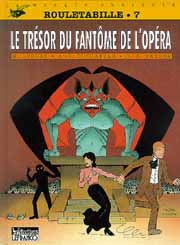 Then, Rouletabille meets the Phantom again in #7, "The Treasure
of the Phantom of the Opera", which takes place "a few years later".
Then, Rouletabille meets the Phantom again in #7, "The Treasure
of the Phantom of the Opera", which takes place "a few years later".
Graphic novels #4-#7 probably take place just after Rouletabille's return from Russia (Routetabille
at the Tsar's -- the third novel), which occurs in 1905-1906. Rouletabille at the Tsar's would therefore come between
#3 and #4 in the graphic novel series. #4-#7 obviously take place during the 1905-1914 gap, since the next novel,
Rouletabille At War, takes place just
before 1914.
In #7, Rouletabille meets Erik again at the Scala of Milan where Christine is singing. The action then moves to
Venice. Rouletabille and Erik end up teaming up against a descendent of Cagliostro who is also a serial killer.
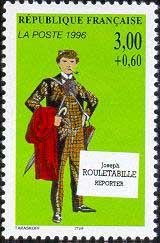






 The leading feuilletoniste of
the Belle Époque was Gaston Leroux,
a writer best known for his classic Le Fantôme de l'Opéra (The Phantom Of The Opera)
(1910), about which little need be said, the tragic yet murderous man-ape Balaoo (1911) and Cheri-Bibi.
The leading feuilletoniste of
the Belle Époque was Gaston Leroux,
a writer best known for his classic Le Fantôme de l'Opéra (The Phantom Of The Opera)
(1910), about which little need be said, the tragic yet murderous man-ape Balaoo (1911) and Cheri-Bibi.  In Le Fantôme de l'Opéra (which takes place in 1880), Leroux skillfully mixed fantastic events with real-life facts.
The novel reads like sensational newspaper accounts of the surreal. When Leroux dealt with fantastic themes, it
was in ways that were resolutely modern, but often derivative of the works of other popular writers, such as Edgar
Allan Poe, H. Rider Haggard, Paul Féval, Alexandre Dumas, etc.
In Le Fantôme de l'Opéra (which takes place in 1880), Leroux skillfully mixed fantastic events with real-life facts.
The novel reads like sensational newspaper accounts of the surreal. When Leroux dealt with fantastic themes, it
was in ways that were resolutely modern, but often derivative of the works of other popular writers, such as Edgar
Allan Poe, H. Rider Haggard, Paul Féval, Alexandre Dumas, etc. In the first novel of the series, Le Mystère
de la Chambre Jaune (published in 1907; allegedly taking place in 1892, although
it is likely that the story actually took place in 1902 according to the series' internal chronology), Rouletabille
solved an attempted murder in a locked room. In the book, Leroux revealed that "Rouletabille" is but
the nickname of 18-year-old journalist Joseph Josephin, who was raised in a religious orphanage in Eu, a small
town on the western coast of France, near Fecamp. It turns out that Rouletabille's father is none other than Ballmeyer, an international criminal of great repute and
many identities. As "Jean Roussel", Ballmeyer had married a rich American heiress, Mathilde
Stangerson, the "Lady in Black" -- Rouletabille's mother.
In the first novel of the series, Le Mystère
de la Chambre Jaune (published in 1907; allegedly taking place in 1892, although
it is likely that the story actually took place in 1902 according to the series' internal chronology), Rouletabille
solved an attempted murder in a locked room. In the book, Leroux revealed that "Rouletabille" is but
the nickname of 18-year-old journalist Joseph Josephin, who was raised in a religious orphanage in Eu, a small
town on the western coast of France, near Fecamp. It turns out that Rouletabille's father is none other than Ballmeyer, an international criminal of great repute and
many identities. As "Jean Roussel", Ballmeyer had married a rich American heiress, Mathilde
Stangerson, the "Lady in Black" -- Rouletabille's mother. The story continued three years later, in 1905, when Ballmeyer returned in the
story chronicled by Leroux under the title of Le Parfum de la Dame en Noir (The Scent of the Lady in Black).
At the end of the story, which took place in a castle by the sea in Southern France, Ballmeyer died, freeing Rouletabille
from the evil shadow of the past.
The story continued three years later, in 1905, when Ballmeyer returned in the
story chronicled by Leroux under the title of Le Parfum de la Dame en Noir (The Scent of the Lady in Black).
At the end of the story, which took place in a castle by the sea in Southern France, Ballmeyer died, freeing Rouletabille
from the evil shadow of the past.









 3. Rouletabille chez les Bohémiens
(B&W., 8000 meters, 1922)
3. Rouletabille chez les Bohémiens
(B&W., 8000 meters, 1922)
 4. Le Mystère de la Chambre Jaune (B&W., 108 min., 1931)
4. Le Mystère de la Chambre Jaune (B&W., 108 min., 1931) 9. Le Mystère de la Chambre Jaune (Col., 90 min., 1949)
9. Le Mystère de la Chambre Jaune (Col., 90 min., 1949)

 1. Le Mystère de la Chambre Jaune (ORTF 1, B&W., 90 min., 27 November 1965)
1. Le Mystère de la Chambre Jaune (ORTF 1, B&W., 90 min., 27 November 1965) 3. Rouletabille chez le Tsar (ORTF 1, B&W., Ten 15 min. episodes, 17 - 30 March 1966)
3. Rouletabille chez le Tsar (ORTF 1, B&W., Ten 15 min. episodes, 17 - 30 March 1966)
 4. Le Mystère de la Chambre Jaune (France-Culture, 25 episodes, 1 August-2
September 1983)
4. Le Mystère de la Chambre Jaune (France-Culture, 25 episodes, 1 August-2
September 1983)
 3. Rouletabille
3. Rouletabille  Then, Rouletabille meets the Phantom again in #7, "The Treasure
of the Phantom of the Opera", which takes place "a few years later".
Then, Rouletabille meets the Phantom again in #7, "The Treasure
of the Phantom of the Opera", which takes place "a few years later".
